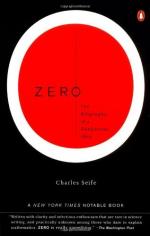
|
| Name: _________________________ | Period: ___________________ |
This test consists of 5 multiple choice questions, 5 short answer questions, and 10 short essay questions.
Multiple Choice Questions
1. Negative numbers first appeared where historically, according to the author in Chapter 3, “Nothing Ventured”?
(a) In Mayan and Native American cultures.
(b) Egypt and Babylonia.
(c) Europe and the Americas.
(d) India and China.
2. What region in the Middle East is widely considered to be the cradle of civilization?
(a) The Twin Towers.
(b) The Mayan Region.
(c) The Nile Region.
(d) The Fertile Crescent.
3. What was the fifth element that Aristotle proposed, in addition to earth, water, fire, and air?
(a) Sanctities.
(b) Aether.
(c) Metal.
(d) Volume.
4. The preclassic Maya and their neighbors supposedly developed the concept of zero by what year?
(a) 10 BC.
(b) 23 BC.
(c) 36 BC.
(d) 50 BC.
5. What refers to a system of tribunals developed by the Holy See of the Roman Catholic Church during the second half of the 16th Century?
(a) The Spanish Inquisition.
(b) The Catalina Inquisition.
(c) The Roman Inquisition.
(d) The Medieval Inquisition.
Short Answer Questions
1. What does the author refer to as “zero’s twin” in the book?
2. How many minutes made up an hour in the ancient Greek system?
3. When the Indians adopted a Babylonian style number system, its base was what, according to the author in Chapter 3, “Nothing Ventured”?
4. What term refers to the worship of multiple deities?
5. Any number multiplied by zero equals what?
Short Essay Questions
1. How did zero enter into Babylonian mathematics, according to the author in Chapter 1, “Nothing Doing”?
2. How are ancient Babylonian mathematics described in Chapter 1, “Nothing Doing”?
3. How did Aristotle approach the concept of zero, according to the author in Chapter 2, “Nothing Comes of Nothing”?
4. How did zero enter into Indian mathematics, according to the author in Chapter 3, “Nothing Ventured”?
5. How was zero dealt with in the Pythagorean view, according to the author in Chapter 2, “Nothing Comes of Nothing”?
6. How does the author describe Islam’s history in the seventh century in Chapter 3, “Nothing Ventured”?
7. How did Filippo Brunelleschi introduce the concept of zero to the Italian Renaissance?
8. How did the Protestant Reformation influence the Aristotelian philosophy in the West?
9. What mathematical advancements were made by the ancient Egyptians?
10. What paradox of Zeno of Elea’s is presented by the author in Chapter 2, “Nothing Comes of Nothing”?
|
This section contains 777 words (approx. 3 pages at 300 words per page) |

|




